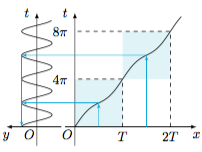对于定义域为 $\mathbb R$ 的函数 $g\left(x\right)$,若存在正常数 $T$,使得 $\cos g\left(x\right)$ 是以 $T$ 为周期的函数,则称 $g\left(x\right)$ 为余弦周期函数,且称 $T$ 为其余弦周期.已知 $f\left(x\right)$ 是以 $T$ 为余弦周期的余弦周期函数,其值域为 $\mathbb R$.设 $f\left(x\right)$ 单调递增,$f\left(0\right)=0$,$f\left(T\right)=4{\mathrm \pi} $.
【难度】
【出处】
无
【标注】
-
验证 $h\left(x\right)=x+\sin \dfrac x3$ 是以 $6 {\mathrm \pi} $ 为余弦周期的余弦周期函数;标注答案略解析本小题考查对新定义的理解.函数 $h\left(x\right)$ 的定义域为 $\mathbb R$,而\[\begin{split} \cos h\left(x+6{\mathrm \pi} \right)&=\cos\left[\left(x+6{\mathrm \pi} \right)+\sin\dfrac{x+6{\mathrm \pi} }3\right]\\
&\overset{\left[a\right]}=\cos\left[x+\sin\left(\dfrac x3+2{\mathrm \pi} \right)\right]\\
&\overset{\left[a\right]}=\cos\left(x+\sin\dfrac x3\right)\\
&=\cos h\left(x\right),\end{split} \](推导中用到:[a])从而根据余弦周期函数的定义,$h\left(x\right)$ 是以 $6{\mathrm \pi} $ 为余弦周期的余弦周期函数. -
设 $a<b$,证明对任意 $c\in\left[f\left(a\right),f\left(b\right)\right]$,存在 $x_0\in\left[a,b\right]$,使得 $f\left(x_0\right)=c$;标注答案略解析本小题考察对函数的值域与单调性的理解.由函数 $f\left(x\right)$ 的值域为 $\mathbb{R}$ 知,对任意 $c\in\left[f\left(a\right),f\left(b\right)\right]$,存在 $x_{0}\in\mathbb{R}$,使得 $f\left(x_{0}\right)=c\in \left[f\left(a\right),f\left(b\right)\right]$,由 $f\left(x\right)$ 单调递增知,$x_{0}\in \left[a,b\right]$,因此原命题得证.
-
证明:“$u_0$ 为方程 $\cos f\left(x\right)=1$ 在 $\left[0,T\right]$ 上的解”的充要条件是“$u_0+T$ 为方程 $\cos f\left(x\right)=1$ 在 $\left[T,2T\right]$ 上的解”,并证明对任意 $x\in\left[0,T\right]$ 都有 $f\left(x+T\right)=f\left(x\right)+f\left(T\right)$.标注答案略解析本小题考查充分必要条件的概念以及推理论证能力,其中利用提示以及复合函数的单调性划分区间是证明结论的关键,之后分段证明即可(类似于配钥匙的过程).若 $u_0+T$ 为方程 $\cos f\left(x\right)=1$ 在 $\left[T,2T\right]$ 上的解,则根据余弦周期函数的定义,有\[\cos f\left(u_0\right)=\cos f\left(u_0+T\right)=1,\]且 $u_0\in\left[0,T\right]$,于是充分性得证.
反之,若 $u_0$ 为方程 $\cos f\left(x\right)=1$ 在 $\left[0,T\right]$ 上的解,则根据余弦周期函数的定义,有\[\cos f\left(u_0+T\right)=\cos f\left(u_0\right)=1,\]且 $u_0+T\in\left[T,2T\right]$,于是必要性得证.
综上所述,“$u_0$ 为方程 $\cos f\left(x\right)=1$ 在 $\left[0,T\right]$ 上的解”的充要条件是“$u_0+T$ 为方程 $\cos f\left(x\right)=1$ 在 $\left[T,2T\right]$ 上的解”,如图.
接下来证明 $\forall x\in\left[0,T\right],f\left(x+T\right)=f\left(x\right)+f\left(T\right)$.
函数 $y=\cos f\left(x\right)$ 可以看作是函数 $y=\cos t$ 和函数 $t=f\left(x\right)$ 的复合函数,如图. 根据第(2)小题的结论,存在 $x_1,x_2,x_3$ 满足 $0<x_1<x_2<x_3<T$,使得 $f\left(x_k\right)=k{\mathrm \pi} $,其中 $k=1,2,3$.为方便叙述,记 $x_0=0$,$x_4=T$.
根据第(2)小题的结论,存在 $x_1,x_2,x_3$ 满足 $0<x_1<x_2<x_3<T$,使得 $f\left(x_k\right)=k{\mathrm \pi} $,其中 $k=1,2,3$.为方便叙述,记 $x_0=0$,$x_4=T$.
当 $x\in \left[x_0,x_1\right]$ 时,函数 $y=\cos f\left(x\right)$ 是单调递减函数,因此每一个自变量的值 $x$ 都唯一对应一个函数值 $\cos f\left(x\right)$.此时 $x+T\in \left[x_0+T,x_1+T\right]$,且根据余弦周期函数的定义,有\[\cos f\left(x+T\right)=\cos f\left(x\right).\]特别地,有 $f\left(x_0+T\right)=f\left(T\right)=4{\mathrm \pi} $,且 $\cos f\left(x_1+T\right)=\cos f\left(x_1\right)=-1$.
下面证明函数 $y=\cos f\left(x\right)$ 在区间 $\left[x_0+T,x_1+T\right]$ 上单调递减:
任取 $\alpha,\beta\in \left[x_{0}+T,x_{1}+T\right],\alpha<\beta$,有 $x_{0}\leqslant \alpha-T<\beta-T\leqslant x_{1}$,由函数 $y=\cos f\left(x\right)$ 在 $\left[x_{0},x_{1}\right]$ 上单调递减知 $\cos f\left(\alpha -T\right)>\cos f\left(\beta -T\right)$,即 $\cos f\left(\alpha\right)>\cos f\left(\beta\right)$,从而得到函数 $y=\cos f\left(x\right)$ 在区间 $\left[x_0+T,x_1+T\right]$ 上单调递减.
综合以上两点,结合余弦函数的单调性,我们有 $f\left(x_1+T\right)=5{\mathrm \pi} $,且对任意 $x\in\left[x_0,x_1\right]$,均有 $f\left(x+T\right)=f\left(x\right)+4{\mathrm \pi} $,命题成立.
类似地,可以证明当 $x$ 在区间 $[x_1,x_2],[x_2,x_3],[x_3,x_4]$ 上时命题均成立,因此原命题得证.
题目
问题1
答案1
解析1
备注1
问题2
答案2
解析2
备注2
问题3
答案3
解析3
备注3